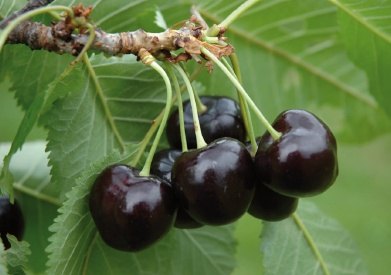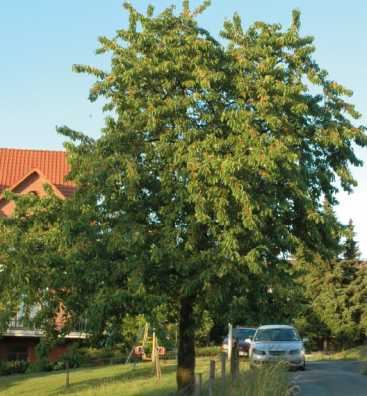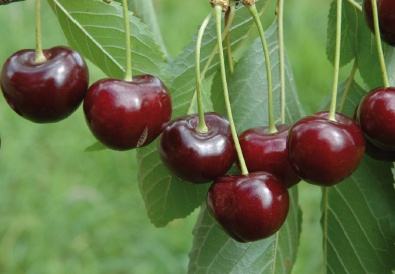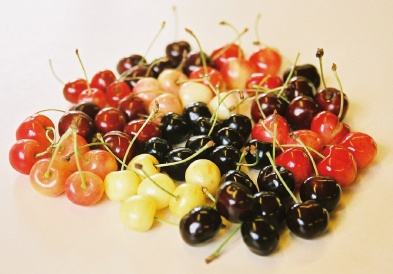
AN INVERTED CHERRY WORLD
Hans-Joachim Bannier
H.-J. Bannier, Pomologen-Verein, 33615 Bielefeld, Germany.
Translated by Reinhard Schomberg-Klee (Göttingen) and Nigel Deacon (Leicester).
This article is about the restricted range of sweet cherries presently cultivated by commercial growers in Germany and elsewhere.
INTRODUCTION
It is an unfortunate fact that many of the best cherries are no longer cultivated. Those older varieties which are the most hardy, best-flavoured, most digestible and most resistant to bursting and fruit fly have almost disappeared. They are no longer grown commercially and most of them are not available as trees in nurseries. Even in cherry breeding programmes they do not play a role; breeders concentrate on fruit size and firmness, so that the crop is easier to handle and does not bruise during transport and packing.
Where do organic growers fit into the picture?
During the last 40 to 50 years, the enormous changes in the range of cherries grown commercially have been dictated principally by economics. Food retailing is now more centrally-controlled. There is increased competition from southern countries where firmer cherries ripen earlier than those in Germany. Consumer habits have also changed.
EARLY RIPENING CHERRIES - DISAPPEARED FROM THE MARKET
In the last few decades, almost all early-season cherries have disappeared from the market in Germany. In earlier times, each cherry grower had different varieties with a range of ripening times, supplying cherries to customers over a six to eight-week period. Customers were knowledgeable about the different kinds; for example, they knew that the very early 'heart-cherries' were softer than the later-ripening 'white-heart' cherries which were picked later in the season.
With the growing influence of the retail chains in the 1960s, the early cherries were soon competing in the supermarket with firmer white-heart cherries from Southern Europe offered at the same time. The retailers began to prefer the imported fruit which was firmer and easier to handle without damage. As a result, Germany now avoids cultivation of early cherries almost completely. In recent years the only early variety still grown was the 'Burlat'.
In Germany the ripening season is divided into the seven 'cherry weeks' which begin at the beginning of May and continue until the end of August. The nomenclature is slightly confusing however, because a 'cherry week' is more like 10-14 days, and the weeks depend on ripening times, not necessarily the calendar.
Different cherry varieties have varying degrees of insect resistance. For example, early cherries are not much affected by cherry fruit fly (see figure 1), but later white-heart cherries are more susceptible to attack. This happens in northern Germany from cherry week 4-5; further south it begins during cherry week 3.
The result: "Cherries from Germany" have to be treated regularly with insecticides when grown conventionally, the last spraying being about a fortnight before harvest. Cherries imported from southern countries into the early cherry season (foreign late-maturing varieties) are similarly treated. Recently this has caused problems in Germany because official permission to use some of the common pesticides has been withdrawn.

figure 1: Early cherries are largely unaffected by maggots, e.g. Landele (Syn. Schwarzer Falter, Mohrenkirsche, Freinsheimer Schwarzkirsche, Westhofener Schwarze, Zipfelbachperle)
Organic farmers therefore have a problem. They need to concentrate more on growing the earlier-maturing varieties such as the softer 'heart-cherries'. Unfortunately these cultivars have almost disappeared from nurseries, so that growers have difficulty in sourcing them; often they do not know which kinds to grow.
Examples of nearly-forgotten dark red cherries which ripen early and are less prone to bursting, include Werdersche Braune, Bernhard Nette, Souvenir des Charmes, Frühe Schwarze, Spitze Braune, Landele (Syn. Schwarzer Falter, Freinsheimer Schwarze, Westhofener Schwarze oder Zipfelbachperle).
It is my view that early varieties like these should again take their rightful place. Breeding programmes for low-pesticide or organic growing should, therefore, be steered in this direction.
BRIGHTLY COLOURED CHERRIES
Another group of cherries which has almost disappeared from the market is the lighter, brightly-coloured sweet cherry. The trade insists nowadays on dark coloured varieties, saying that consumers will not buy the others. Today, the commercial cherry is almost always heart-shaped and dark red to black in colour.
It was not always so. According to Hubert Schneider, consultant of Kaiserstühler fruit wholesale market Vogtsburg-Oberrotweil (Baden), bright varieties were recommended for cultivation in Baden as late as the 1970s. A surprising advantage of lighter cherries is that they are less messy to eat; clothes do not get stained by them, yet the advertisers never mention this, only showing pictures of darker fruit.
Late brightly-coloured cherries like Weiße Spanische, Büttners Rote Knorpel or Grosse Prinzessin (Syn. Napoleon), once mass produced, have disappeared from commercial production. Maibigarreau, Kunzes Kirsche or Lucienkirsche are gone, along with some regional varieties:Garrns Bunte, Stechmanns Bunte (Altes Land/Lower Elbe), Geisepitter (Middle Rhine), Kronprinz von Hanover(Lower Saxony), Großerote (Middle Franconia), Türkine (Thuringia), and the many Swabian bicoloured cherries (eg Esslinger Schecken, Köbles Schecken, Bersigheimer Schecken).
Their disappearance has little to do with taste, quality or ease of cultivation; they have flavours as good as modern commercial cherries like Regina or Hedelfinger and they are less liable to cause digestive upsets.
In terms of cultivation the coloured cherries offer other advantages. The earlier bright varieties are less likely to be attacked by birds because for most of their life they are lighter in colour and less easily seen. Compared to darker varieties maturing at the same time, bright cherries are generally less susceptible to the cherry fruit fly maggot. Some of the coloured varieties have excellent health and taste (Kunzes Kirsche, Weiße Spanische, Tilgeners Rote Herzkirsche or Garrns Bunte) and the crown shape of the trees is easy to manage. Disease resistance is often good; for example: Garrns Bunte is resistant to shot-hole disease.
Another advantage of the bright-skinned cherries is that they generally have firmer skin, so are less prone to bursting. Lucienkirsche is particularly good in this respect; its taste is not outstanding but it is burst-resistant and can be harvested in good condition over a two-week period, and it survived as a commercial variety at Hagen until the 1970s. Garrns Bunte (see figure 2) and Kunzes Kirsche also show low susceptibility to bursting.

figure 2: Do coloured varieties have a chance? This is Garrns Bunte, a regional variety from Altes Land; relatively burst-resistant, maggot free, resistant to shothole disease and suitable for cool regions
With a little more imagination, organic farmers could, instead of following market trends, start to publicise and re-establish 'bright' cherries in the marketplace. So far the horticultural industry has not given the idea serious consideration.
Coloured varieties which are worthy of consideration include: (early varieties) Köbles Schecken, Kunzes Kirsche, Garrns Bunte, Maibigarreau, Kronprinz von Hannover, Tilgeners Rote Herzkirsche, Lucienkirsche, and (mid to late varieties) Weiße Spanische, Große Prinzessin, Büttners Späte Rote Knorpelkirsche, Grolls Bunte, Merton Late, Grevenbroicher Knorpelkirsche.
BREEDING, FRUIT SIZE AND SELF-FERTIILITY
During the last twenty years, when breeding new cherries, increased fruit size has been one of the main objectives. Part of the reason is that harvesting costs are lower with larger fruit; they are easier to pick. Varieties such as Regina, Kordia, and Sunburst today are a few millimeters larger in diameter than most of the old sweet cherry cultivars, though Schneiders Späte Knorpel was a notable exception; the only old variety comparable in size to the new commercial breeds.
What is cost-saving for the fruit farmer, however, often means a loss of flavour for the consumer. Regina (queen) does not taste as good as its name or size suggests. Many of the older varieties (eg Grolls Schwarze, Schneiders Späte Knorpel, Badeborner Schwarze, Werdersche Braune) or many of the bright varieties which we have found during field collection projects in recent years have a superior taste, and none of the new varieties is so well suited for jam-making as the pitch-black Landele.
THE LATEST CRAZE: SELF-FERTILE CHERRIES
Most sweet cherry trees need cross-pollination in order to fruit, and the rules for pollination are relatively complex. To produce fruit, a tree must receive pollen from a different 'fertility group'. Choose the wrong combination of trees and you'll get a poor crop.
This has caused breeders to work on the development of self-fertile varieties. The Canadian cherry Stella was the first, followed by Lapins, Sweetheart, Sunburst, Skeena, Grace Star, Earlystar, Lalastar, Newstar, Sumpaca / Celeste and others.
Self-fertile varieties sound tempting, especially for a garden owner or private grower, because there is no need for a nearby pollinator, and customers are easily convinced by this argument. Unfortunately many of these cultivars are prone to fruit burst, brown rot disease or bacterial canker because they are bred from disease-prone varieties like Stella, Lapins or Van. This is a problem for organic growers.
However, some of the old sweet cherries may already be self-fertile, and this would be worth investigating. For example, I know a tree of Garrns Bunte in a secluded location in Hagen which bears heavily each year and which does not seem to be pollinated by any other tree. Others have noticed the same thing; orchard consultant Hubert Schneider, for example, assumed a few years ago that some old varieties were self-fertile and that it was fairly common to find an isolated cherry tree bearing a regular crop.
BREEDERS' AND CONSULTANTS' PREDICTIONS
It seems that breeders and consultants in the fruit industry are often interested in developing and promoting their varieties before they have been adequately tested. Usually they show little interest in the genetic potential of the older types.
A striking example in cherry growing is Van, a modern Canadian variety promoted in Germany in the 1970´s, mainly for private cultivation, though there was some commercial production. Private gardeners still grow it, and in the 1970s and 1980s there were great hopes for it.
In 1970, Götz (in "Süß- und Sauerkirschen") said that it was a promising new variety, with mainly good qualities which would ensure its widespread commercial use.
In 1986, Silbereisen (in "Obstsortenatlas") said that Van was a remarkable new variety whose early fruiting season, regular yield and good size made it attractive for both commercial growers and the hobbyist.
Now, many years later, we know that Van is more susceptible to brown rot than almost all other sweet cherries, and that if there was a world championship for fruit cracking during wet weather, Van would win the prize. Anyone who has grown it is familiar with the whole crop bursting and rotting well before it is ripe; sometimes year after year.
In ecological terms, the widespread use of Van in breeding new varieties is best described as a mistake.
Ironically there is an old sweet cherry ripening at the same time as Van which looks and tastes as good: Grolls Schwarze, developed around 1860 and still around in traditional orchards. The only significant difference is that the older variety is much healthier; it does not suffer much from brown rot and its fruit are less prone to cracking.
Nevertheless Grolls Schwarze is almost unknown today and nurseries rarely stock it; the same is true of Maibigarreau. (see figure 3)

figure 3: Coloured varieties have outstanding tree health in traditional orchards; this is Maibigarreau, 2nd cherry week
Another over-promoted variety is the large fruiting cherry Regina, which is often described, inaccurately, as burst-resistant and promoted as such by its breeders. In fact it bursts more freely than many other varieties.
THE MAIN THING - IT'S MODERN!
When I told the story of Van and Grolls Schwarze (see figure 4) recently to an Austrian nurseryman who already stocked Van in his nursery, he said "But nobody knows the name Grolls Schwarze...perhaps it would be better to sell it in the future instead of Van and write 'Van' on the label!

figure 4: Some tasty top-quality old varieties have virtually disappeared; this is Grolls Schwarze ,white-heart cherry, 5th cherry week
Unknown to him, something very similar had already happened. Years ago an unknown black-red early cherry was discovered, good enough to be marketed. The grower who found it gave it a modern name and applied for Plant Variety Protection. Some time later it was found to be the old variety Werdersche Braune. An inverted cherry world!
However in this article the new variety name will remain anonymous; I do not want to expose a person to criticism for reintroducing a robust old cultivar back into the marketplace.
It is unfortunate for the fruit industry and its customers that most cherry breeders do not regard older varieties as anything more than historical curiosities. They are, apparently, fit only for the museum! We heard this sentiment expressed at the meeting of the "Expert Stone Fruit Group" in Witzenhausen in 2008 when pomologist Annette Braun-Lüllemann was explaining the value of specific old varieties for organic farming, direct marketing and breeding of new cultivars.
It is evident that attitudes must be changed.
ORGANIC GROWERS NEED A NEW CHERRY PRODUCTION STRATEGY
Present-day organic cherry cultivation is mainly focused on controlling the cherry fruit fly. As regards the other main problem, fruit burst; the only protection, apart from selecting less prone varieties, is protection from rain: covers or canopies.
We need a separate strategy for selecting varieties for organic or low-pesticide growing, producing cherries suitable for wholesale or direct marketing. One could envisage an advertising campaign to popularize suitable varieties cultivated under organic conditions. Careful choice of variety would enable spending on crop protection measures to be minimised. The problem is that knowledge of the older varieties and their potential rarely exists. (see figure 5)

figure 5: Colourful cherry diversity discovered in old orchards; today only a few of these old varieties are available in nurseries.
Would it be possible, perhaps, to evaluate a medium-sized, brightly coloured, burst-resistant cherry with low susceptibility to cherry fruit fly? Perhaps Kunzes Kirsche, Garrns Bunte or Tilgeners Rote Herzkirsche could be considered, or the pitch-black early cherry Landele, which is highly aromatic and maggot-free and which can be grown without pesticides.
Growing a higher proportion of early varieties would help reduce the fruit fly problem.
It seems that organic cherry growing needs its own breeding programme, in which the vitality of the plant, the taste of the fruit and the healthiness of the plant is combined with the lowest possible use of plant protection products.
The current programme aimed at the supermarkets, focused solely on fruit size, self-fertility and fruit firmness is not the answer.
ADVICE FOR PRIVATE GROWERS & INDIVIDUALS
The professional market is important, but other growers should be considered too. Private gardeners have different requirements from the professionals in choosing which fruit cultivars to grow. Some sensible advice, quite separate from the needs of the commercial markets, is needed.
For example, most gardeners growing cherries for their families do not want to use pesticides on the developing fruit.
Perhaps an organization such as the German Pomological Society could devise a private-grower "variety strategy", with its own trademark. The information could be made available in nurseries and in horticultural magazines.
It would be important to list varieties which perform well and grow healthily without the need for spraying. Other important criteria would include low infestation by cherry fruit fly, low susceptibility to fruit burst, and easy tree management.
COPYRIGHT DECLARATION
This English version is based on the original article, "Verkehrte Kirschenwelt", which appeared in the annual bulletin of the German Pomological Society , 2011 and (slightly abridged) in Öko-Obstbau, March 2011.
Original text and pictures © H-J Bannier.
English version © Reinhard Schomberg-Klee (Göttingen) and Nigel Deacon (Leicester); reproduced by permission.
Back to top
Radio Plays
![]()
Apples
![]()
Fruit
![]()
Potatoes
![]()
Vegetables
![]()
Wine Making
![]()
Music
![]()
Artwork
![]()
Habitat21
![]()
Cosby Methodist Church
![]()
Gokart Racing
![]()
Sitemap
![]()
Links to other Sites
![]()
Contact Us
![]()